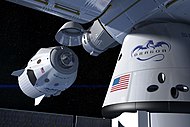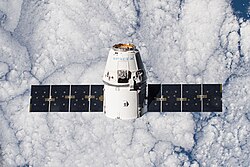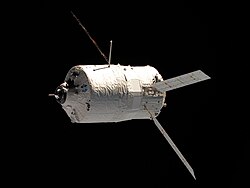SpaceX CRS-8
| SpaceX CRS-8 | |||
 | |||
| Beställare | NASA | ||
|---|---|---|---|
| Tillverkare | SpaceX | ||
| Modell | Dragon | ||
| Farkost | C110 | ||
| Operatör | SpaceX | ||
| Färdens tid | 32 dagar, 21 timmar, 48 minuter | ||
| NSSDC-ID | 2016-024A[1] | ||
| Uppskjutning | |||
| Startplats | Cape Canaveral SLC-40 | ||
| Raket | Falcon 9 v1.2 | ||
| Uppskjutning | 8 april 2016, 20:43 UTC[2] | ||
| Landning | |||
| Landningsplats | Stilla havet | ||
| Landningstid | 11 maj 2016, 18:55 UTC | ||
| Omloppsbana | |||
| Banlutning | 51,6° | ||
| Dockning | |||
| Rymdstation | ISS | ||
| Greppad | 10 april 2016, 11:23 UTC | ||
| Dockning | 10 april 2016, 13:57 UTC | ||
| Dockningsport | Harmony, nadir | ||
| Ur dockning | 11 maj 2016 | ||
| Släppt | 11 maj 2016, 13:19 UTC | ||
| Last upp | |||
| Upp | 3 136 kg | ||
| Tryck satt | 1 723 kg | ||
| Tryck löst | 1 413 kg | ||
| Kronologi | |||
| |||

SpaceX CRS-8 eller SpX-8 avsåg ett obemannat lastuppdrag till Internationella rymdstationen med SpaceX:s rymdfarkost Dragon. Farkosten sköts upp den 8 april 2016 från Cape Canaveral Air Force Station, med mål att leverera farkostens last, däribland modulen Bigelow Expandable Activity Module (BEAM), till rymdstationen. Farkosten dockade med rymdstationen den 10 april 2016.
Efter att ha fyllts med material som skulle tillbaka till jorden, lämnade farkosten stationen den 11 maj 2016, några timmar senare återinträdde den i jordens atmosfär och landade i Stilla havet.
Efter uppskjutningen lyckades SpaceX landa bärraketens första steg, på pråmen OCISLY ute på Atlanten, ungefär 300 km öster om Cape Canaveral.
Källor
Referenser
- Den här artikeln är helt eller delvis baserad på material från engelskspråkiga Wikipedia, tidigare version.
Fotnoter
- ^ ”NASA Space Science Data Coordinated Archive” (på engelska). NASA. https://nssdc.gsfc.nasa.gov/nmc/spacecraft/display.action?id=2016-024A. Läst 2 mars 2020.
- ^ ”blogs.nasa.gov” (på engelska). NASA. https://blogs.nasa.gov/spacex/2016/04/07/the-crs-8-mission-overview. Läst 23 juli 2016.
| ||||||||||||||||||||||||||||||||||||||||||||||||||||||||
| ||||||||||||||||||||||||||||||||
| ||||||||||||||||
Media som används på denna webbplats
Författare/Upphovsman: SpaceX, Licens: CC0
This artist's concept shows a SpaceX Crew Dragon docking with the International Space Station as it will during a mission for NASA's Commercial Crew Program. NASA is partnering with Boeing and SpaceX to build a new generation of human-rated spacecraft capable of taking astronauts to the station and expanding research opportunities in orbit.
Författare/Upphovsman: Space Exploration Technologies Corp., Licens: CC0
The 2018 version of the Big Falcon Rocket at stage separation: Starship (foreground) and Super Heavy (background)
A Progress supply ship linked up to the orbiting International Space Station (ISS) at 3:48 GMT, November 18, bringing Expedition 1 commander William M. Shepherd, pilot Yuri P.
Gidzenko and flight engineer Sergei K. Krikalev two tons of food, clothing, hardware and holiday gifts from their families. The photograph was taken with a 35mm camera and the film was later handed over to the STS-97 crew members
for return to Earth and subsequent processing.Backdropped by a cloud-covered part of Earth, the Orbital Sciences' Cygnus cargo craft approaches the International Space Station, photographed by an Expedition 40 crew member. The two spacecraft converged at 6:36 a.m. (EDT) on July 16, 2014.
ISS021-E-017623 (30 Oct. 2009) --- Backdropped by a cloud-covered part of Earth, the unpiloted Japanese H-II Transfer Vehicle (HTV), filled with trash and unneeded items, departs from the International Space Station. European Space Agency astronaut Frank De Winne, Expedition 21 commander; NASA astronaut Nicole Stott and Canadian Space Agency astronaut Robert Thirsk, both flight engineers, used the station's Canadarm2 robotic arm to grab the HTV cargo craft and unberth it from the Harmony node's nadir port. The HTV was successfully unberthed at 10:18 a.m. (CDT) on Oct. 30, 2009, and released from the station's Canadarm2 at 12:32 p.m.
This image, photographed by one of the Expedition 42 crew members aboard the International Space Station, shows the SpaceX Dragon cargo craft approaching on Jan. 12 2015 for its grapple and berthing and the start of a month attached to the complex. Dragon carried more than 2 ½ tons of supplies and experiments to the station.
ISS026-E-037172 (24 Feb. 2011) --- Surrounded by the blackness of space, the European Space Agency's "Johannes Kepler" Automated Transfer Vehicle-2 (ATV-2) approaches the International Space Station. Docking of the two spacecraft occurred at 10:59 a.m. (EST) on Feb. 24, 2011.
NASA's insignia for the ninth Commercial Resupply Services flight to the ISS, which will be taking up the International Docking Adaptor-2.
NASA's insignia for SpaceX's Commercial Resupply Services-7 (CRS-7) mission to the International Space Station (SpX-7)
NASA's insignia for SpaceX's Commercial Resupply Services-8 (CRS-8) mission to the International Space Station (SpX-8).
Författare/Upphovsman: SpaceX Photos, Licens: CC0
First stage of a Falcon 9 Full Thrust rocket on the autonomous spaceport drone ship (ASDS) Of Course I Still Love You. The stage landed successfully after launching the SpaceX CRS-8 resupply mission to the ISS. According to SpaceX, the photograph was taken from a NASA chase plane.

















